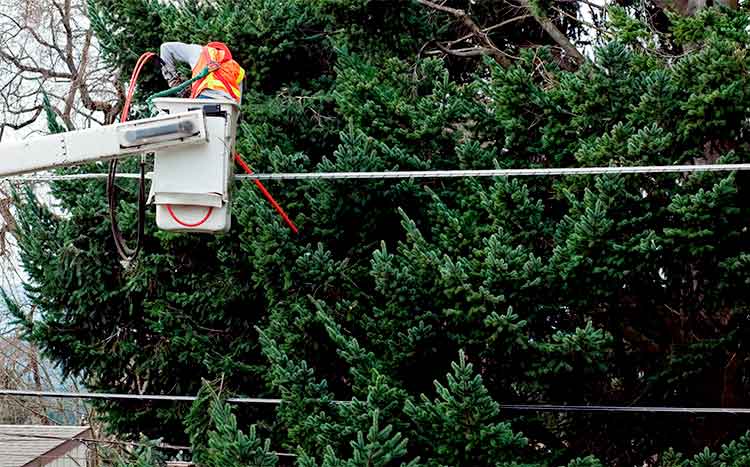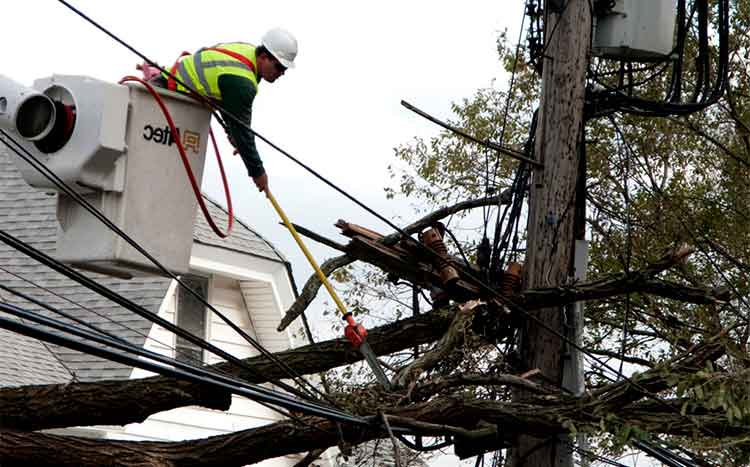Power distributors consider trees growing near power lines a risk because they usually destroy the power lines, start fires and or cause power surges.
Depending on local and state laws, the responsibility to trim or remove trees near power lines may lie on the homeowner or utility company. Some states, such as South Australia, place the responsibility on utility companies, while others, like New South Wales, place it on homeowners.
There are several situations you need to be aware of…
| Situation | Responsibility |
|---|---|
| Street tree touching stree power lines | Council/ Utility company |
| Street tree touching your service line to your home | Council/ Utility company |
| Your tree touching your service line to your home | Homeowner |
| Your tree touching street power lines | Homeowner |
Table of contents
ToggleWho Is Responsible for Tree Limbs on Power Lines In NSW?
You as the property owner or occupier, are responsible for trees in your property that could interfere with power lines according to the Electricity Industry Safety Steering Committee Guidelines. This is if the tree grows on your land and not the boundary line. Only licensed professionals in the state can trim or remove trees near power following NSW’s electrical safety guidelines.
However, NSW residents can also notify utility companies if they have trees interfering with power lines in or around their property. All the utility companies in NSW have continuous vegetation management programs to limit or prevent damage from trees on their infrastructure. Electrical companies are responsible for trees on council land or boundaries in NSW.

Who Is Responsible for Tree Limbs on Power Lines in Victoria?
Property owners are responsible for keeping private trees clear of private lines within their property or their neighbour’s property. Utility companies are responsible for clearing trees that interfere with lines on the street or other areas. This is according to Victoria’s current powerlines and vegetation management guidelines as published by the Victorian government.
However, the state also requires power distributors and councils to develop annual electric line clearance plans that they must make public. The plans must also be submitted to Energy Safe Victoria for approval before making them public.
Energy Safe Victoria also recommends that you cut trees before they grow to within one meter of insulated electrical lines and two meters of bare electrical wires. You are not allowed to remove or trim vegetation near high-voltage transmission lines. ESV advises you to talk to a trained professional or the electrical companies whenever you want to clear tree limbs on power lines.
Who Is Responsible for Tree Limbs on Power Lines in Tasmania?
Property owners are responsible for clearing vegetation inside their property that may interfere with their service line or that of their neighbours if the tree is on the boundary line. This is according to guidelines published by Tasmania’s energy ombudsman.
TasNetworks, Tasmania’s sole electric distributor, is responsible for clearing vegetation near service lines on the street or public transmission lines. The company has a comprehensive year-round program aimed at maintaining vegetation around its power lines and other electrical infrastructure.
Who Is Responsible for Tree Limbs on Power Lines in Western Australia?
The owners or occupiers of land with trees are responsible for keeping them clear of all power lines up to 33,000 volts according to Western Australia’s Guidelines for the management of vegetation near power lines. Local councils are responsible for cultivated trees on street verges while power companies are responsible for naturally occurring trees on street verges, and reserves.
Any of the network operators in Western Australia can notify a private landowner or occupier if their tree is too close to a power line. Should they refuse to remove or trim it in good time, the network operator has the right under these guidelines to enter the property and remove or trim the tree at the owner’s cost.
Some rural towns within Western Australia also have Network operator Contributory Extension Schemes (CES). CESs are signed between landowners or occupiers and power companies or network operators and include a maintenance component. The power company will manage all vegetation where these agreements exist.
Who Is Responsible for Tree Limbs on Power Lines in South Australia?
Both power distributors and landowners are responsible for clearing vegetation near their power lines in South Australia according to the state’s Electricity Regulations (Principles of Vegetation Clearance) 2010. Here is a breakdown of South Australia’s guidelines on power line vegetation:
- Cultivated vegetation inside private land- landowner or occupier’s responsibility
- Naturally occurring vegetation inside private land- Electric distributor’s responsibility
- Trees near public power lines- – Electric distributor’s responsibility
- Trees near power lines serving more than one customer-Electric distributor’s responsibility
See the illustration below for more guidance on who is responsible for trimming or removing trees near power lines in South Australia:
Who Is Responsible for Tree Limbs on Power Lines in Queensland?
Electricity entities in Queensland are responsible for trimming or removal of trees near their overhead electrical lines. This is according to current Queensland electrical safety guidelines. The three main electrical distributors in Queensland (Energex, Ergon, and Essential Energy) have year-round tree management programs under different names and schedules depending on the areas they serve.
Energex has a program named the safe tree program whose aim is to trim trees near their power lines. They routinely publish a factsheet of their tree trimming activities that members of the public can download from their safe tree program webpage. Energex also encourages residents to plant trees away from power lines or plant powerline-friendly plants.
Ergon also has an active vegetation management program for their coverage areas in Queensland. The company works with several contractors to help with trimming where needed. Like Energex, Ergon also encourages property owners and occupiers to plant powerline-friendly plants.
Lastly, Essential Energy has a continuous vegetation management program. Residents in their coverage areas will be notified of impending vegetation management work through mail or by a representative of the company going door to door.
What Do You Do When A Tree Limb Falls on A Power Line?
You should notify the power distributor or hire a qualified tree trimmer if a tree limb in your property falls on a power line. It is dangerous and illegal in Australia for unqualified or unauthorized personnel to attempt to climb or trim a tree near a powerline. Power distributors can be reached on their hotlines and will send an inspector over to check on the tree.
Is It Safe to Cut A Tree Limb Touching Power Lines?
Only trained and experienced workers should cut tree limbs touching power lines for safety. Untrained people may get electrocuted while cutting such branches through accidental contact with uninsulated lines or getting too close to high-voltage transmission lines. Hire a qualified trimmer to remove any tree limbs touching power lines at the earliest opportunity.
Tip: Need help finding an experienced tree trimmer near you? Why not use our free contractor location tool? It is simple to use, enter your zip code in the search box at the top of this page and follow the instructions below it.
Can I Touch A Power Line Going from The Street to My House?
While the power line coming from the street to your house may be a low voltage one and insulated, it is not safe to touch it as you might get electrocuted. Call the utility company if you have a problem with the line.
FAQ's
Powerline-friendly plants are short plants that will not reach a height that breaches the two-meter safety distance from overhead power lines. Most electrical companies and network operators in Australia encourage property owners and occupiers to plant powerline-friendly plants or have a safe distance between existing power lines and where they plant trees.
Healthy or wet tree branches are dangerous if they are touching power lines because they can conduct electricity. The branches usually get energized when they come into contact with uninsulated power lines. Dry branches may also cause a fire if they come into contact with power lines.













